Garden Roof Assembly FAQ

What are the benefits of a Green Roof?
The benefits of a green roof or vegetative roof are as follows:
1. Green roofs are a great stormwater management tool because they have the ability to capture all or portions of a typical rainfall event. This rainwater is stored in several areas of the assembly – within the open pore spaces in the growing media and within the drainage/water retention system that underlays the media.
This total assembly handles stormwater in several ways.
- It retains a portion of the stormwater until the green roof assembly is completely saturated.
- It delays the release of excess stormwater from the building roof and into site stormwater system.
- It reduces the volume of stormwater runoff and releases some of this rainwater into the atmosphere by evaporation and transpiration through the plantings.
- It cleans the rainfall of particulate matter and chemicals within acid rain through the filtering actions of the plant material, growing media, system filter, and drainage layers.
In these ways, vegetated roofs mimic natural hydrology systems like wetlands and similar structures. The complete assembly is simultaneously an engineered and biological system designed to manage stormwater.
2. Green Roof help to combat the urban heat island effect by reducing the ambient temperature of cities. Installing vegetation to replace impervious surfaces at the roof, amenity deck, and plaza level helps to create a cooler, shadier, and more pleasant climate. Plants absorb around 50% of sunlight, reflect about 30%, and provide natural cooling through evapotranspiration, all of which helps both the indoor and outdoor efficiencies of the building and in turn translates to energy savings. Studies have shown that vegetative roofs can reduce a city’s ambient air temperature by up to 5 degrees Fahrenheit and lower the surface temperature of the roof by up to 30 to 40 degrees Fahrenheit compared to conventional roofs.
3. Green roofs increase the efficiency of solar panels by creating a cooler roof environment, which leads to higher voltage output and improved energy conversion efficiency.
4. Green roofs are often implemented as an effective and aesthetically pleasing sound barrier. By reducing the ambient noise both inside and outside of the building a quieter environment is created.
5. Green roofs extend the life span of a roof by protecting the roofing material from both mother nature and physical abuse. It can double or triple the life span of your roof upwards of 60 years or longer to provide long-term costs savings.
6. Green roofs increase the biodiversity of the surrounding area. They create new habitats and provide food and shelter for a variety of plants and animals, especially in urban environments.
7. Green roofs have been linked to an increased feeling of well-being and therapeutic benefits. Offices that offer green space can significantly improve productivity, foster socialization among employees, and reduce stress. Studies have shown that hospitals that have healing gardens and interactive play areas can help facilitate the healing process for patients, as well as their families and friends.
How important is access to water on a Vegetated Roof?
Water access at the roof level is an important design consideration that is often forgotten or an afterthought in the design of a green roof. Access to sufficient water is one of the most important considerations for establishing and maintaining healthy vegetated roofs. After the establishment period, most extensive vegetated roofs can rely predominantly on natural rainfall with occasional supplemental watering needed when natural rainfall amounts fall short.
Are Garden Roofs® really "no maintenance"?
There is no such thing as a no-maintenance vegetated roof.
Hydrotech highly recommends that a maintenance contract be in place on all vegetated roofs. Maintenance is critical during the establishment period to help ensure the long term success of a project.
The amount of maintenance needed on vegetated roofs taper down as the plant material becomes more established and mature. Vegetated roofs cannot perform as intended without maintenance.
Aside from the thrive and coverage warranty that Hydrotech can provide if we supply the vegetation, there are additional reasons Hydrotech strongly recommends maintenance. Below are key points that need to be considered.
- Green roofs are a significant investment. Maintenance is a relatively small cost to protect this investment.
- Keeping a watchful eye on the roof will maximize plant health, maintain the aesthetics of the roof, and ensure any systems such as drains, parapets, vegetation free zones and irrigation systems are performing as designed.
- Healthy plants transpire water which is an essential function on Green Roofs to manage stormwater, keep the roof cool and help mitigate the urban heat island effect.
- If the vegetative roof is not maintained invasive weeds can take over a roof. This not only can lead to an unsightly roof but the specified plant material could completely die out and be taken over by invasive species. Some invasive species have aggressive root systems which could potentially compromise the waterproofing membrane.
Please contact the Hydrotech Garden Roof Department for additional information about best maintenance practices.
What vegetation option is right for your Extensive Garden Roof?
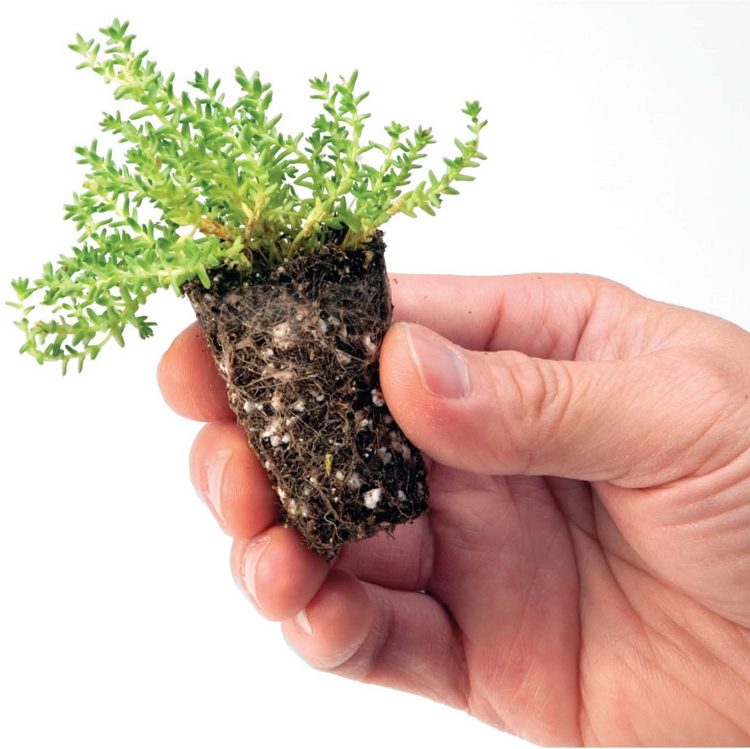
Vegetation selection requires understanding a wide range of factors, including microclimates, which could ultimately affect the success of a green roof project. Hydrotech has 25 years of experience on green roofs all across the country and can assist in vegetation selection for your project based on your design intent.
Hydrotech offers a wide variety of extensive plants including perennials as plugs and sedums in several formats including cuttings, plugs, and pre-vegetated InstaGreen® Sedum Carpets and InstaGreen® Sedum Tiles. Each planting method allows for various degrees of design flexibility and coverage rates. Each method has particular requirements for establishment and maintenance
Hydrotech offers city specific plant lists which can be used as a great starting point for the vegetation of your Green Roof. These lists include natives, grasses and succulents appropriate for your project's location.
Vegetation selection factors include:
- Climate
- Hardiness Zone
- Rainfall
- Wind
- Sun / Shade
- Visibility
- Biodiversity
- Desired coverage at installation
- Year round interest
- Life span
- Vegetation size
- Growing media depth
- Planting time
- Anticipated level of maintenance
- Warranty
- And many more…
Extensive Vegetation Options
Sedum Cuttings
Cuttings from sedum plants can provide a very effective and economical vegetated roof. Blends of cuttings can provide a wide array of textures and flower colors for the vegetated roof.
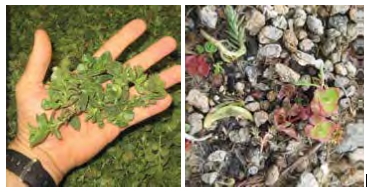
Sedum and Perennial Plugs
Custom grown plugs of a wide range of sedums, natives, grasses and other perennials are also available. Plugs can give the designer nearly unlimited freedom to create swaths of color and texture on the roof.
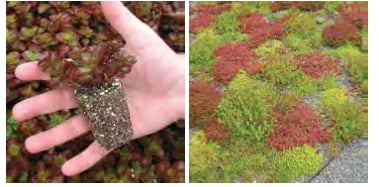
InstaGreen® Sedum Carpet
For a vegetated roof that is completely green once completed, Hydrotech offers InstaGreen® Sedum Carpet. Provided in approximately 4' x 6' (25 S.F.) rolls that are laid out onto the prepared media like sod, Sedum Carpet has a range of sedums that provide nearly complete coverage on Day 1 of the vegetated roof. Using sedum carpet can greatly decrease the installation time and maintenance of your Green Roof.
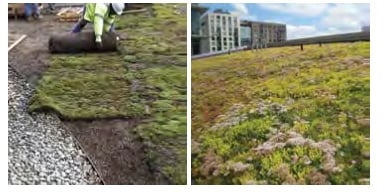
InstaGreen® Sedum Tile
In another format that creates an instantly green roof, Hydrotech offers InstaGreen® Sedum Tiles. Created in a 15" x 20" (2 S.F.) tile format, Sedum Tiles are available in four standard blends to address most roof top conditions, Sedum Tile is also available in custom blends.
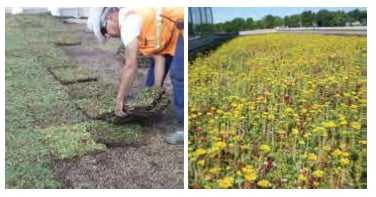
Southern Climates
In the southern part of the country most sedum are not a viable option. While most sedum is not recommended for the south, there are many types of succulents, natives, grasses and perennials that can be used to vegetate your Garden Roof. Please contact Hydrotech for specifics.
What are the stress signs for your Extensive Garden Roof?
Its summer, and in many parts of the country that means hot and dry weather, which can be the most stressful part of the year for a Green Roof. There are a number of signs which can help you gauge the stress level of the vegetation on the roof. If you know what to look for, you can take the proper steps to resolve the issues before the roof sustains long term damage.
Vegetation Signals

WILTING VEGETATION – If the plantings are still getting established, wilting vegetation can mean the roof is receiving too much or too little water. Irrigation settings should be regularly checked, and adjusted accordingly.
RECEDING VEGETATION – Many extensive plants, whether they be sedums, perennials, or native grasses have a tendency to recede when stressed. Though some this is normal for some species during times of stress, if left unchecked it can be fatal for plants on the roof. Extensive vegetation, whose media substrate can be thinner, and thus dry out more quickly and become warmer, and have a disadvantage to their at-grade counterparts.
BURNT or SINGED VEGETATION – This often occurs either at the perimeters of Green Roofs where vegetation directly adjacent to hardscape - which can carry a higher temperature, or the result of reflective light. If possible, irrigation should be increased in these areas to offset some of the heat. If the area remains an issue, measures should be taken to incorporate vegetation free zones (with cooler temperatures) for the problematic areas.
Media Signals

EXPOSED MEDIA – Areas on the roof may have exposed media because the roof has not yet established, or in the summer and fall months, because the plants have receded or migrated on the roof. While exposed media itself is not particularly damaging, it can lead to pressure from weeds. It is important to keep the green roof weed free and remove any weeds as soon as possible.
DRY MEDIA – Areas throughout the roof should be checked for moisture. If there is no dampness to the media, irrigation should be increased. Irrigation settings will vary due to region and plant material.
As with all Green Roof projects, a regular maintenance schedule is key to long term, sustained success. For specific questions and concerns, please contact your Local Hydrotech Representative or the Garden Roof Department.
What is dormancy and how does is effect my green roof?
A majority of plant life functions best when there is ample water and favorable temperatures. However, with the exception of tropical regions, most plants are exposed to dry periods and/or temperatures below freezing for some period of time during the year. Unlike animals, plants do not have the ability to add insulation through fat stores or a winter coat, nor do they have the ability to relocate. Instead, plants go through a period of dormancy.
Dormancy is a state in which plants exhibit little or no growth and in which most, if not all metabolic activity ceases for a period of time. It is typically triggered by cooler weather and a reduction in sunlight, but also can be brought on by stress due to heat or drought. These changes in climate are nature’s mechanisms to inform the plants that they need to start shutting down for the upcoming winter months. The plant goes into dormancy at this time because it can no longer make enough food from photosynthesis to support active growth.
Nearly all plants in temperate regions go dormant in winter, including those on your Garden Roof. Most deciduous plants, including some sedums, shrubs, and trees, lose their leaves in preparation for dormancy, in order to protect themselves against upcoming damaging weather conditions. With the onset of freezing temperatures, deciduous plants must protect themselves against water freezing and then rupturing their cells.
Evergreen plants also go dormant, but less conspicuously than their deciduous counterparts. While evergreen trees and shrubs do not grow, pollinate, or produce seeds during dormancy, they retain their leaves or needles. This holds true for some species of evergreen sedums, which will hold onto their foliage, but typically take on an orange or reddish color during dormancy.
The onset of dormancy emphasizes the importance of ensuring plants are properly established and healthy heading into the winter months. Ideally, plants within newly installed landscapes have the opportunity to get established for at least a few weeks, and uptake water into their roots and stems and (evergreen) leaves part of their normal processes. This water will prevent the plants from drying out during dormancy. If plants do not have the opportunity to establish and uptake water, they will dry out and the Green Roof becomes susceptible to desiccation or winter burn.
Although dormancy can be considered a quiet time for your Garden Roof, many plants provide winter interest throughout the winter months. Evergreen sedums turn orange, red, and brown, ornamental grasses provide color and texture, and woody plants even without their leaves, can provide structure. A plants dormant state and how it can contribute to the aesthetic of your project should be considered when designing your Green Roof project.
Dormancy will come to an end in spring, the weather starts to warm and the days get longer, and plants can resume their normal processes. Spring is typically a great time to check nutrient levels within the media, which should be amended as necessary based on the type of plantings. This will ensure plants have all the vital nutrients for a successful growing season.
What is the weight of a Garden Roof?
It depends on the type of assembly and the depth of the soil. Extensive Garden Roofs can range from 22-45 pounds per s.f. (saturated). Lawn Garden roofs range from 35-90 pounds per s.f. (saturated), and Intensive Garden Roofs can be anywhere from 35 pounds per s.f. up to whatever weight the structure can safely hold. Weights will vary by region and design intent.


